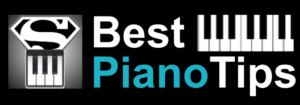Today you’re going to learn about a jazz improv chord progression that you’ll be able to play within a week. If you’re a beginner, it’ll look hard initially, but once I break it down for you, you’ll see that it’s much easier to learn than you think.
In the video above, I demonstrate this easy jazz piano improvisation, and I’ll explain exactly how to get to that point in this blog post. There are four things we’ll go through:
- Left Hand Chord Progression
- Improvising With the Right Hand
- How to Learn it FAST
- My Top 5 “Money Patterns”
Let’s get into it!
Left Hand Chord Progression
This seems complicated, but it’s much easier than it looks. The first step is to play an F major 7 chord. You’ll play an F, then you’ll simply skip a note, play a note, skip a note, play a note, skip a note, play a note. So, the sequence is:
F – A – C – E
This is your first chord.
For the second chord, all you do is move your thumb and index fingers down one note. Then, the next step is to move your pinky and ring finger down one note. After that, you’ll again move your thumb and index fingers down a note. Next, move your pinky and ring fingers down a note again. Take a look at the video to see exactly what I mean, but all we’re doing is alternating moving the top two fingers down a note with moving the bottom two fingers down a note. Now that we have the left hand chord progression for easy jazz piano, we’ll move on to right hand improvisation.
Improvising With the Right Hand
This is going to look difficult, but here’s the trick: If you use this chord progression, you can use any white note on the keyboard and it’s always going to sound good.
If you watch the video, you’ll see exactly what I mean. I play a variety of white notes with my right hand as I’m going through the left hand chord progression and they all sound good.
How to Learn it FAST
If you’re already advanced as a piano player you’ll probably pick this up in five minutes. If you’re a beginner, I promise you can learn this left hand part in less than 3 days if you follow the exact steps I’ll go through. I know this because I’ve taught lots of students and this is how long it typically takes.
Instead of playing the entire left hand chord progression I mentioned before, just play the first two notes. Repeat them 8 times. Then, we take the next two notes and practice them 8 times as well. Once you’ve gotten that down, we’re going to start over and play the first three notes 8 times.
Each time you practice, I want you to focus on accuracy. At this point I don’t care how fast you play it, I just want you to drill down the notes so you get the correct muscle memory.
Now, we’ll take the first four notes and practice them 8 times. After we get the first four notes, we’ll jump to the whole progression.
Again, if you’re a complete beginner, you might have to go through this entire progression three days in a row before it gets completely drilled in.
Once you have the left hand down, you want to start adding the right hand. Of course, you don’t want to start with a super complicated right hand and have it be confusing or overwhelming for you. Start your right hand with just one note, C.
You’ll play the progression with your left hand while your right hand is playing just one note. Next, you’ll start playing different notes with your right hand, but still just one note at a time. You’ll practice this until it becomes second nature and then you can add two notes at a time. At this point, once you have all of that down, you can start improvising. Next, I’ll show you a few of my favorite money patterns, but make sure you have this part down first.
My Top 5 “Money Patterns”
The first money pattern involves using a blues note. For this, you’ll play E flat on the keyboard. When you play this note, it’ll give it a very “Blues-y” feel. You hear how this sounds my video demonstration. What you don’t want to do is spam the blues note, playing it way too frequently. That’ll just be too much. By the way, my favorite is to go E flat and then play D, C. Try it out.
For the next money pattern you’ll use sixths. This is another thing that looks really impressive, but is super easy to play. All you do is take a C to an A, that’s a sixth, and if you keep your hand position, use that muscle memory, you can take that hand position and play it on any white notes and it’ll sound good. This gives the song a very loungy or jazz feel to it.
The third money pattern is seventh chord rolls. All you do is take a seventh chord, like we did with the left hand, and do the same with our right hand, just adding a roll to it. So, instead of playing it as a chord, you roll it. Again, the video will help demonstrate this visually if you’d like to see it. To practice this, it’s almost like you’re playing it as a chord, but rolling your wrist to be able to roll the notes. The best place to add these is at the end of a phrase.
The fourth little trick I call “octave transpositions.” For this, you play any riff, any three to five note pattern, and then you play it up an octave and then up another octave. This gives a little sparkle to the song.
The fifth pattern is what I call “three note drops.” All you do is take three notes, play them descending, then you take the next three notes, one down, and play them descending, and continue on. This gives it a cascading feel and you can use this with any rhythm.
Want to learn more? I provide additional tips, tactics, and strategies in my free course, Become a Piano Superhuman.

